So, with all of the changes we made to the studio on Memorial Day weekend, I just had to put my theory into practice....and get my quilt done in time for the quilt show that I already entered it into!
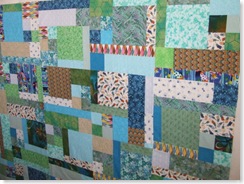 This is a Turning Twenty Again pattern, measuring 89" x 75"
This is a Turning Twenty Again pattern, measuring 89" x 75"
I used a batik border and a batik back, and there is at least one batik in the piecing. This is the first time I've quilted a project with batik...and it was a learning experience!
 I loaded this quilt last Sunday and proceeded to mess around with trying to get my tension right. You see, I can't use the same stitching scenario all the time! The Innova handles all kinds of threads, and I want to experiment! That's what gets me in trouble, I guess... ;-)
I loaded this quilt last Sunday and proceeded to mess around with trying to get my tension right. You see, I can't use the same stitching scenario all the time! The Innova handles all kinds of threads, and I want to experiment! That's what gets me in trouble, I guess... ;-)
I used a new-to-me thread called PolyQuilter, from Superior Threads, which is a 19 wt spun polyester thread that feels like cotton. It's really soft, and it is just gorgeous! I didn't pay attention to the weight of the thread on the package, and it never occurred to me I would have to make adjustments, as you would with a decorative thread. Well, maybe that's just me....
I only realized it was such a fat thread when I went to thread the needle. It was much easier to use the size 18 needle just to get it through the eye, which worked out really well because of the batik back. I like to test my tension on loops and swirls in order to test everything I might encounter during the actual quilting. I've used an 18 before with no problems, but, for some reason, I ended up needing to re-time the machine this time because I was getting skipped stitches on my practice loops.
This, of course, necessitated a call to ABM technical support, which is always great. Michael was very patient with me as he walked me through several steps, making sure I was liking how the tension was set and how the thread laid on the back. In order to not have the threads "lying on the top of the fabric" we ended up moving the needle bar height so that the hopping foot was about a dime's height above the quilt top, where I usually have it set to a nickel's height. However, by the time that was all set, it was time to go to bed!
I used Willow Leaf Studio's Koko pantograph. Although I've used a pantograph before, this is the first panto I've used on my machine. 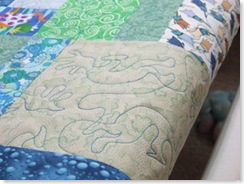 Overall it was a pretty easy pattern to follow, although I found that I jerked on the edges of the little musical instrument too much and I have several points, rather than rounded edges. That was probably me going too fast, as I have a tendency to be impatient. Also, since I have the 26" machine, I wish I had more than one row on the pattern so I didn't have to roll so much. Once I figured out the placement and rolling technique, I started to feel much more comfortable with the entire process. I used about
Overall it was a pretty easy pattern to follow, although I found that I jerked on the edges of the little musical instrument too much and I have several points, rather than rounded edges. That was probably me going too fast, as I have a tendency to be impatient. Also, since I have the 26" machine, I wish I had more than one row on the pattern so I didn't have to roll so much. Once I figured out the placement and rolling technique, I started to feel much more comfortable with the entire process. I used about
1- 1/2 rows per bobbin, and I used about 8 bobbins.
I LOVE how the thread looks on the back! It's actually more interesting than how it looks on the front. This is part of that learning experience I was talking about...
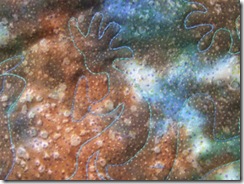
So, this quilt has taken me a whole week to complete, except for the binding, which I am going to finish this weekend. 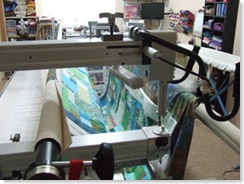
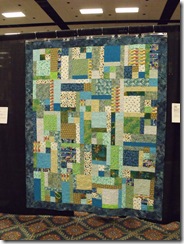 For the Design components, which include Use of Color & Fabric, Top Design, and Quilting Design, I got a “+”.
For the Design components, which include Use of Color & Fabric, Top Design, and Quilting Design, I got a “+”.







